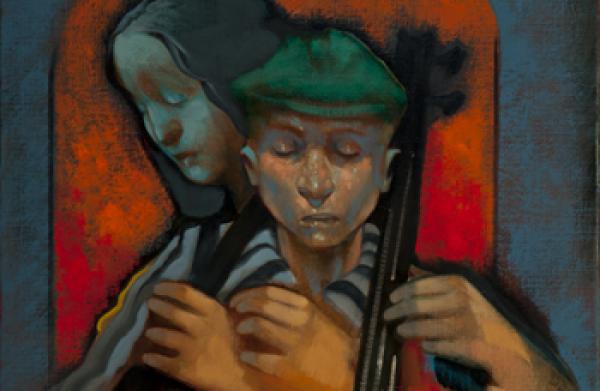Volume 19: Out of the Whirlwind

March 05, 2013
PDF Download
Can one fashion art from unspeakable evil?
That conundrum lies at the heart of Volume 19 from the Milken Archive of Jewish Music: The American Experience. And it is one with which many American Jewish artists have wrestled.
"Is it possible to write songs about Auschwitz, or, even more important, is it permitted to do so?" composer Gershon Kingsley asks in the spoken narration to Voices from the Shadow, a collection of songs based on poetry written by Holocaust victims and survivors.
Like Ruth Schonthal (String Quartet No. 3) and Lukas Foss (Elegy for Anne Frank), Kingsley witnessed the rise of Nazism in Germany before escaping to America. And he turns a declarative statement by the German philosopher Theodor Adorno—"to write poetry after Auschwitz is barbarism"—into a provocative query. (Adorno may well have had one particular poem in mind when he wrote those words: Todesfuge, a shattering evocation of the death camps by the Romanian-Jewish survivor Paul Celan that serves as the basis for Aaron J. Kernis' Death Fugue.) For both men, Auschwitz was shorthand for the Holocaust in general. And despite the passage of years, the fundamental issue remains: Can one even begin to address the horror of genocide in artistic form without somehow trivializing it?
There are no simple answers to a question like that. Yet each composer in Volume 19 has offered his or her own personal rejoinder—a unique artistic response to the senseless brutality of the Holocaust.
Many give musical voice to those who experienced the terror firsthand by setting their poetry to music. (Bruce Adolphe takes a similar tack in the eponymous Out of the Whirlwind, albeit with original treatments of Yiddish songs.) Kingsley, for example, strings together a collection of perfectly turned miniatures to form a song-cycle of great emotional range, from the urgent "Ver zenen mir?" ("Who Are We?") to the gently wrenching "Shlof mayn kind" ("Sleep My Child"). In Voices from Terezin, which sets poems by two inmates at the notorious Theresienstadt concentration camp—one who survived, and one who did not—Robert Stern uses subtle shifts in harmony and dynamics to create a musical world that is at once beautiful and disturbing. And Simon Sargon (Shema) sets several poems by the Italian writer and Holocaust survivor Primo Levi, including one that paraphrases the Hebrew prayer affirming the Jewish faith in one God. Sargon incorporates a fragment of the prayer melody in a contrapuntal texture that becomes progressively more strident, then goes on to musically depict such disparate images as a menacing crow and an idyllic prewar Italy.
Other American Jewish composers mine the Judaic tradition itself for inspiration. In Di Naye Hagode (The New Haggadah), Max Helfman uses elements of the ritual Passover meal to set a Yiddish poem celebrating those who participated in the Warsaw Ghetto Uprising; listen carefully, and you'll hear the singsong melody of Ma nishtana, or the Four Questions, transformed as thoroughly as the reflection in a funhouse mirror. David Stock (Yizkor) and Jan Radzynski (Kaddish), meanwhile, craft very different instrumental pieces based on the Jewish prayers for the dead: In Yizkor, a veil of strings traces a lovely melody with a vaguely cantorial contour, while Kaddish is a tapestry of exotic sonorities (buzzing swarms of angry strings, dark scrims of sound conjured from some mysterious grouping of instruments) that moves from languor to frenzy. In terms of sheer adventurousness, Kaddish is matched only by Kernis' Death Fugue, in which a parade of unusual sounds—bent tympani notes, a croaking bass-baritone that leaps abruptly to falsetto—provides a disorienting backdrop to Celan's concentration-camp imagery. And it is worlds away from Yidn zingen ani maamin, a heartbreaking lied by Lazar Weiner, master of the Yiddish art song (see Volume 9, The Art of Jewish Song), which alludes to the Hebrew prayer that many recited on their way to the gas chambers.
Still others use musical personification to commemorate those who perished in the camps. Joelle Wallach, for example, assigns each of the eight instruments in From the Forest of Chimneys the role of a different inmate at the Birkenau death camp, their distinct melodies coming together and drifting apart like characters in a series of brief encounters. Foss uses a childlike piano melody to represent the ill-fated young Dutch girl who hid with her family in an attic for two years before being carried off to her death. And Schonthal has the voices in her quartet portray four different wartime experiences. "The listener is meant briefly to relive these moments," says the composer, whose writing conveys anguish and desolation, panic and distress to uncanny effect.
Works such as these—beautiful, haunting, and at times profoundly unsettling—help us to grapple with an event whose awfulness defies rational explanation, and enjoin us to remember its victims. Like the eternal flames that flicker at Holocaust memorials around the world, they burn in our hearts and minds, urging us never to forget.
Founded in 1990 by philanthropist Lowell Milken, the Milken Archive of Jewish Music reflects the scope and variety of Jewish life in America. The Archive’s virtual museum www.milkenarchive.org is an interactive guide to music, videos, oral histories, photos and essays.
For information or interviews, contact media@milkenarchive.org .
Connect with us on Facebook at www.facebook.com/MilkenArchive and on Twitter at www.twitter.com/milkenarchive.
